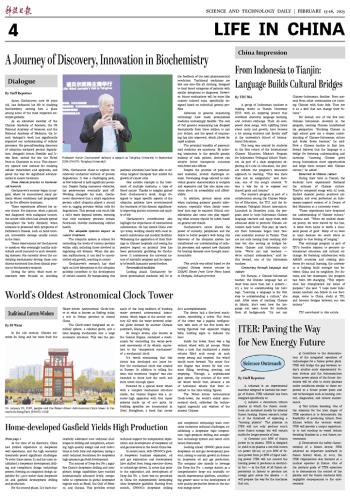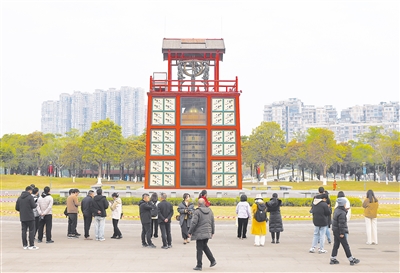
 |
| On January 26, 2024, people visit the Water-driven Astronomical Clock-tower in Xiamen's Su Song Park. (PHOTO: VCG) |
In the 11th century, Chinese scientist Su Song and his team built the Water-driven Astronomical Clock-tower in what is known as Keifeng today, a city in Henan province in central China.
The Clock-tower integrated an armillary sphere, a celestial globe, and a time-keeping mechanism into a large automatic structure. This was the pinnacle of the long tradition of building water-powered astronomical instruments, which began in the second century AD with the water-powered celestial globe devised by another Chinese polymath, Zhang Heng.
Su Song's device, also known as the Cosmic Engine, contained a mechanism for controlling the water-powered movements of its wheels, equivalent to the "escapement mechanism" of a mechanical clock.
It's worth mentioning that this device was developed 200 years before the mechanical clock was created in Europe. In addition to telling the time, this enormous "engine" was also intended to show how the earth and stars travel through space.
Powered by a special water wheel with a complex mechanical structure inside, the Cosmic Engine was a 12-meter-high apparatus with four major systems made up of 400 parts. Its building specifics are documented in Xinyi Xiangfayao, a book that covers Su's accomplishments.
The device had a five-level mechanism, resembling a tower. The front of the tower was a pagoda configuration with each of the five levels featuring figurines that appeared ringing bells, holding signs to indicate the hour.
Inside the tower, there was a big vertical wheel with 36 scoops. Water from a tank that maintained a steady volume filled each scoop. As each scoop swung and emptied, the wheel would move forward. The entire Cosmic Engine was driven by this constant filling, revolving, pivoting, and emptying. Through a sophisticated gear system, the rotation of the vertical wheel would then advance a set of horizontal wheels that were attached to the time-telling figures.
The Water-driven Astronomical Clock-tower, the world's oldest astronomical clock, embodies the technological ingenuity and wisdom of the ancient Chinese.







